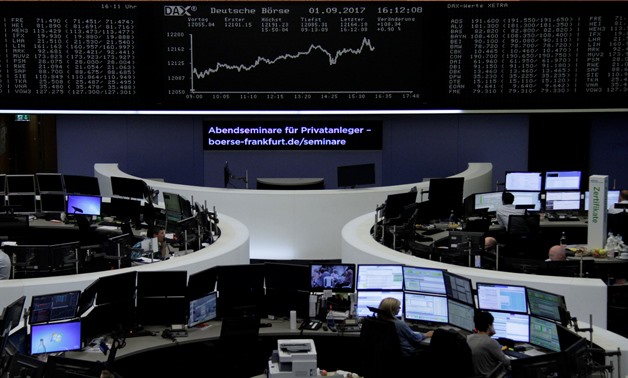
Traders work in front of the German share price index, DAX board, at the stock exchange in Frankfurt, Germany, September 1, 2017. REUTERS/Staff/Remote
LONDON - 2 September 2017: Global investors raised their euro zone equity exposure to the highest level in at least five years in August, citing loose central bank policy, robust growth and strong company earnings.
They cut their U.S. stock holdings to 13-month lows.
The finings come from Reuters monthly asset allocation polls of 48 fund managers and chief investment officers in Europe, the United States, Britain and Japan, conducted between Aug. 16-29.
In this period the euro zone delivered its best manufacturing performance in 6-1/2 years despite a strong euro, whilst the European Central Bank (ECB) maintained its ultra-easy monetary policy.
Poll participants lifted euro zone stock allocation to 20.5 percent of their global equity portfolios, with almost 90 percent of managers who answered a question on the outlook for European equities saying they could touch fresh highs this year.
Since May the market has come off the boil and looks set to end August down 0.7 percent, yet managers cited cheap relative valuations, strong growth momentum and positive earnings revisions as reasons to be cheerful.
Didier Saint-Georges, managing director and member of the investment committee at Carmignac, struck a note of caution. Although he thought a short-term recovery was possible, he said analysts’ estimates were no longer being revised upwards and ECB tapering was looming.
“If the U.S. market holds its own, there is room for a second wind in European equities. Otherwise, the latter will struggle to perform much,” he said.
Investors cut their U.S. equity holdings almost 1 percentage point to 38.5 percent in August, the lowest level since July 2016. The S&P 500 .SPX is ending August down around 0.5 percent after volatile trading.
It fell 1.5 percent on Aug. 17, its biggest daily loss in three months, on fresh concerns President Donald Trump will be unable to deliver on his campaign promises to cut taxes and boost spending.
SHUTDOWN
A late-September deadline is now looming for U.S. officials to raise the debt ceiling or risk default. Trump has threatened to shut down the U.S. government in order to secure funding for a border wall with Mexico.
Yet 84 percent of managers who answered a question on the funding battle thought the chance of a U.S. technical default was less than 50/50.
“The huge fiscal, economic and reputational costs that emerge from a technical default suggest an intense game of chicken that could result in a compromise around the last week of September,” said Peter van der Welle, a strategist at Robeco.
He thought U.S. equities and other risky assets could take a hit, as the political hassle around the debt ceiling could reduce the likelihood of congressional approval for Trump’s tax and infrastructure plans, while higher Treasury yields would imply higher funding costs for U.S. corporates.
The United States and North Korea are also at a tense nuclear stand off, an issue that wiped $1 trillion off global shares mid-month.
But investors who answered a question on this issue were unanimous in saying they did not expect a military confrontation between the United States and North Korea before year-end.
Despite the mid-month selloff, investors raised their overall equity allocation by 1 percentage point to 47.1 percent, the highest level since January 2016. But several managers expressed caution, with some warning that volatility would increase if central banks started to tighten in concert.
Trevor Greetham, head of multi-asset at Royal London Asset Management (RLAM), also noted that valuations were starting to get a bit stretched.
“There is a risk that excessive hawkishness from central banks or escalation in geopolitical events could trigger a more pronounced sell off than we’ve seen so far this year, but we would be willing to buy the dip given a benign longer term outlook for growth and inflation,” he said.


Comments
Leave a Comment